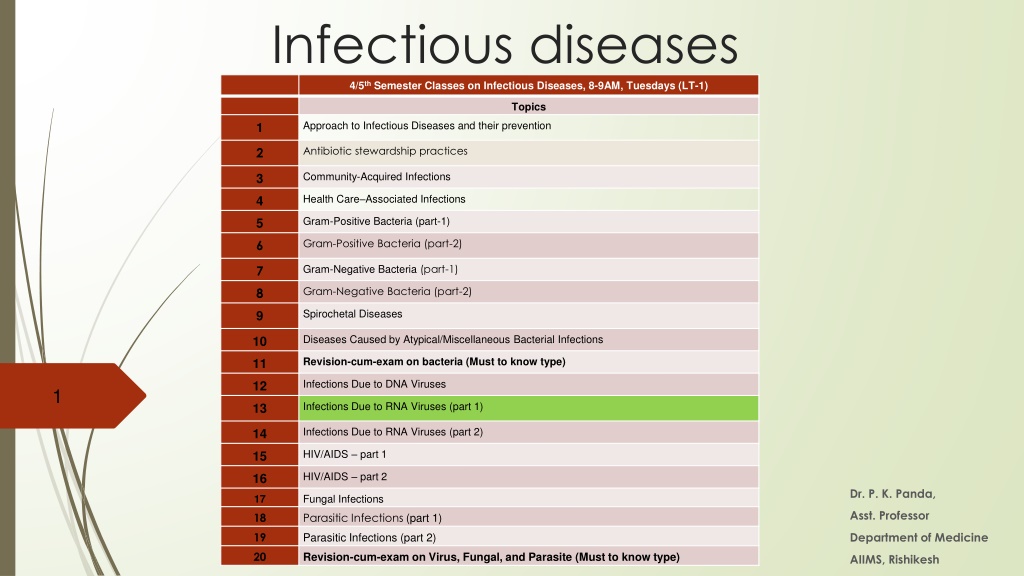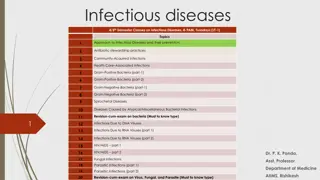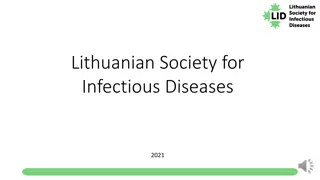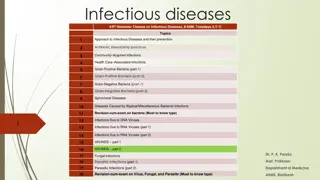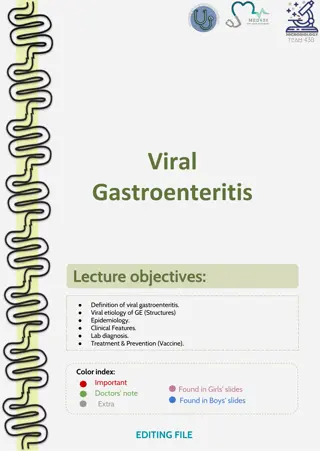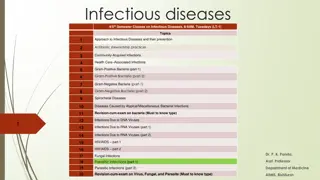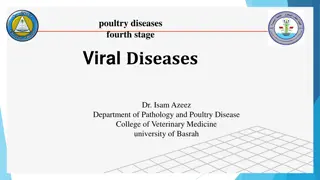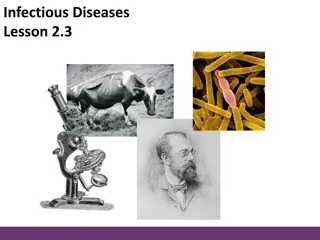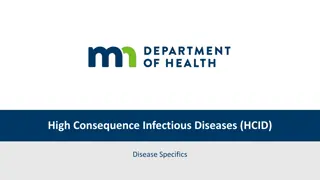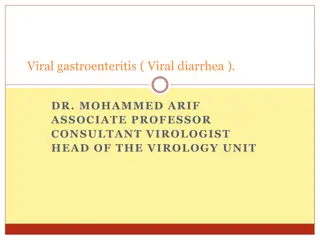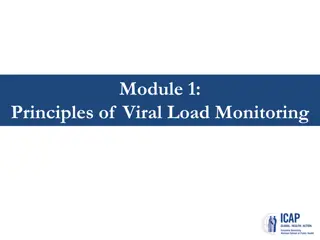Understanding Infectious Diseases: Approach, Prevention, and Viral Agents
Infectious diseases play a significant role in public health, with a focus on antibiotic stewardship, community-acquired and healthcare-associated infections, as well as various bacterial, viral, fungal, and parasitic agents. Specific topics include the prevention of infectious diseases, with a detailed examination of gram-positive and gram-negative bacteria, spirochetal diseases, viral infections like HIV/AIDS, and parasitic infections. The content also delves into key aspects of norovirus and other common viral agents, shedding light on their transmission, clinical manifestations, and impact on vulnerable populations.
Download Presentation

Please find below an Image/Link to download the presentation.
The content on the website is provided AS IS for your information and personal use only. It may not be sold, licensed, or shared on other websites without obtaining consent from the author. Download presentation by click this link. If you encounter any issues during the download, it is possible that the publisher has removed the file from their server.
E N D
Presentation Transcript
Infectious diseases 4/5thSemester Classes on Infectious Diseases, 8-9AM, Tuesdays (LT-1) Topics Approach to Infectious Diseases and their prevention 1 Antibiotic stewardship practices 2 Community-Acquired Infections 3 Health Care Associated Infections 4 Gram-Positive Bacteria (part-1) 5 Gram-Positive Bacteria (part-2) 6 Gram-Negative Bacteria (part-1) 7 Gram-Negative Bacteria (part-2) 8 Spirochetal Diseases 9 Diseases Caused by Atypical/Miscellaneous Bacterial Infections 10 Revision-cum-exam on bacteria (Must to know type) 11 Infections Due to DNA Viruses 12 1 Infections Due to RNA Viruses (part 1) 13 Infections Due to RNA Viruses (part 2) 14 HIV/AIDS part 1 15 HIV/AIDS part 2 16 Dr. P. K. Panda, Fungal Infections Parasitic Infections (part 1) 17 18 Asst. Professor Department of Medicine 19 Parasitic Infections (part 2) 20 Revision-cum-exam on Virus, Fungal, and Parasite (Must to know type) AIIMS, Rishikesh
Norovirus may be the second most common viral agent (after rotavirus) among young children By the fecal-oral route but can occur by aerosolization, by contact with contaminated fomites, and by person-to-person contact The stools are characteristically loose and watery, without blood, mucus, or leukocytes
These viruses are not a prominent cause of gastroenteritis. 3 serotypes of poliovirus, 21 serotypes of coxsackievirus A, 6 serotypes of coxsackievirus B1, 28 serotypes of echovirus, enteroviruses 68 71, and multiple new enteroviruses (beginning with enterovirus 73) Infection is more common in socioeconomically disadvantaged areas, especially in those where hygiene is poor Transmitted primarily by the fecal-oral or oral-oral route, other rare route also IP; 2 to 14 days but usually is <1 week After ingestion, it infect epithelial cells in the mucosa of the gastrointestinal tract and then to spread to and replicate in the submucosal lymphoid tissue, then to the regional lymph nodes, a viremic phase ensues, and the virus replicates in organs of the reticuloendothelial system
Most common clinical manifestation is a nonspecific febrile illness Poliovirus Infection: Abortive poliomyelitis Nonparalytic poliomyelitis Paralytic poliomyelitis - it is more common among older individuals, pregnant women, and persons exercising trenuously or undergoing trauma Vaccine-associated poliomyelitis Postpolio syndrome - a new onset of weakness, fatigue, fasciculations, and pain with additional atrophy of the muscle group involved during the initial paralytic disease 20 40 years earlier
Isolation of enterovirus in cell culture is the traditional diagnostic procedure Identification of the enterovirus serotype is useful primarily for epidemiologic studies A pan-enterovirus PCR assay can detect all human enteroviruses Intensive supportive care may be needed for cardiac, hepatic, or CNS disease. IV, intrathecal, or intraventricular immunoglobulin has been used with apparent success in some cases for the treatment of chronic enterovirus meningoencephalitis and dermatomyositis in patients with hypogammaglobulinemia or agammaglobulinemia. Poliovirus is shed from some immunocompromised persons for >10 years, discontinuing vaccinations is difficult to decide
RHINOVIRUS - In contrast to other picornavirus, rhinoviruses are acid-labile and are almost completely inactivated at pH 3 Seasonal peaks in early fall and spring; spread through direct contact with infected secretions, usually respiratory droplets; IP- 1-2 DAYS Antibacterial agents should be used only if bacterial complications such as otitis media or sinusitis develop CORONAVIRUS - that infect humans (HCoVs) fall into two genera: Alphacoronavirus (common cold) and Betacoronavirus (SARS-CoV and MERS-CoV) - it is suspected that bats may be the animal reservoir Person-to-person transmission has been documented; IP 2-7DAYS SARS usually begins as a systemic illness marked by the onset of fever, which is often accompanied by malaise, headache, and myalgias and is followed in 1 2 days by a nonproductive cough and dyspnea, then ARDS in second week HUMAN RESPIRATORY SYNCYTIAL VIRUS - (HRSV)- A common cold like syndrome is the illness most commonly associated with HRSV infection in adults (both upper and lower respiratory tract illnesses, such as bronchiolitis, croup, and pneumonia) HUMAN METAPNEUMOVIRUS - (HMPV) - similar to that associated with HRSV PARAINFLUENZA VIRUS - In older children and adults, parainfluenza infections tend to be milder, presenting most frequently as a common cold or as hoarseness, with or without cough
Hemagglutinin is the site by which the virus binds to sialic acid cell receptors, whereas the neuraminidase degrades the receptor and plays a role in the release of the virus from infected cells after replication has taken place Influenza A viruses are further subdivided (subtyped) on the basis of the surface hemagglutinin (H) and neuraminidase (N)
Because the genome is segmented, the opportunity for gene reassortment during infection is high; reassortment often takes place during infection of cells with more than one influenza A virus Major antigenic variations, called antigenic shifts, are seen only with influenza A viruses and may be associated with pandemics; Minor variations are called antigenic drifts Interpandemic influenza A outbreaks usually begin abruptly, peak over a 2- to 3-week period, generally last for 2 3 months, and often subside almost as rapidly as they began In contrast, pandemic influenza may begin with rapid transmission at multiple locations, have high attack rates, and extend beyond the usual seasonality, with multiple waves of attack before or after the main outbreak Aquatic birds are the largest reservoir of influenza A viruses; pandemic strains resulted from reassortment of gene segments between human and avian viruses Whereas humans primarily have -2,6-galactose receptors for hemagglutinins and birds primarily have -2,3-galactose receptors, swine have both types of receptors Influenza is most frequently described as a respiratory illness; severe with risk factors Pulmonary Complications as PNEUMONIA: primary influenza viral pneumonia, secondary bacterial pneumonia, or mixed viral and bacterial pneumonia Myositis, rhabdomyolysis, and myoglobinuria are occasional complications
CDC case definition for measles requires (1) a generalized maculopapular rash of at least 3 days duration; (2) fever of at least 38.3 C (101 F); and (3) cough, coryza, or conjunctivitis IP: is 10 days to fever onset and 14 days to rash onset with Airborne transmission D/D: rubella, Kawasaki disease, infectious mononucleosis, roseola, scarlet fever, Rocky Mountain spotted fever, enterovirus or adenovirus infection, and drug sensitivity Serology is the most common method of laboratory diagnosis Paradoxically associated with depressed immune responses to unrelated antigens, which persist for several weeks to months that enhances susceptibility to secondary infections with bacteria and viruses that cause pneumonia and diarrhea
Spread from person to person via respiratory droplets Primary implantation and replication in the nasopharynx are followed by spread to the lymph nodes, then other organs or placenta in congenital rubella syndrome The pathology of CRS in the infected fetus is well defined, with almost all organs found to be infected; however, the pathogenesis of CRS is only poorly delineated Acquired rubella commonly presents a subclinical and mild disease: a generalized maculopapular rash that usually lasts for up to 3 days; Lymphadenopathy, particularly occipital and postauricular, may be noted during the second week after exposure The hallmark of fetal infection is chronicity, with persistence throughout fetal development in utero and for up to 1 year after birth
Laboratory assessment of rubella infection is conducted by serologic and virologic methods Demonstration of IgM antibodies in an acute-phase serum specimen or a fourfold rise in IgG antibody (the acute-phase serum specimen should be collected within 7 10 days after onset of illness and the convalescent-phase specimen ~14 21 days after the first specimen) Mature (high-avidity) IgG antibodies most likely indicate an infection occurring at least 2 months previously (This test helps distinguish primary infection from reinfection) Symptom based treatment for various manifestations, such as fever and arthralgia, is appropriate Administration of immunoglobulin should be considered only if a pregnant woman who has been exposed to rubella will not consider termination of the pregnancy under any circumstance The most effective method of preventing acquired rubella and CRS is through vaccination with an MMR/MMRV (globally RA27/3 virus strain)
Illness characterized by acute-onset unilateral or bilateral tender, self-limited swelling of the parotid or other salivary gland(s) that lasts at least 2 days and has no other apparent cause Now frequently occurs in older age groups primarily college students, most of whom were vaccinated in early childhood IP: 19 days (range, 7 23 days); transmitted by the respiratory route via droplets, saliva, and fomites Primary replication likely occurs in the nasal mucosa or upper respiratory mucosal epithelium; THEN salivary glands, testes, pancreas, ovaries, mammary glands, and central nervous system (CNS); Other unusual complications include thyroiditis, nephritis, arthritis, hepatic disease, keratouveitis, and thrombocytopenic purpura Typical mumps encephalitis appears to be secondary to respiratory spread and is probably a parainfectious process Mumps parotidits, usually within 24 h of prodromal viral symptoms Detection of viral RNA by RT-PCR or on serology Therapy for parotitis and other clinical manifestations is symptom based and supportive
Treatment consists of general supportive measures, such as hydration and administration of antipyretic agents Prompt antibiotic treatment for patients who have clinical evidence of bacterial infection; Streptococcus pneumoniae and Haemophilus influenzae type b are common causes of bacterial pneumonia following measles Once-daily doses of 200,000 IU of vitamin A for 2 consecutive days to all children with mea Most complications of measles involve the respiratory tract (croup, Giant-cell pneumonitis, Otitis media, and bronchopneumonia) and include the effects of measles virus replication itself and secondary bacterial infectionsles who are 12 months of age Postmeasles encephalomyelitis - within 2 weeks of rash onset and is characterized by fever, seizures, and a variety of neurologic abnormalities Measles inclusion body encephalitis (MIBE- occurs months after infection) and subacute sclerosing panencephalitis (SSPE- occurring 5 15 years after measles) Prophylaxis with immunoglobulin is recommended for susceptible household and nosocomial contacts who are at risk of developing severe measles, particularly children <1 year of age, immunocompromised persons (including HIVinfected persons previously immunized with live attenuated measles vaccine), and pregnant women
